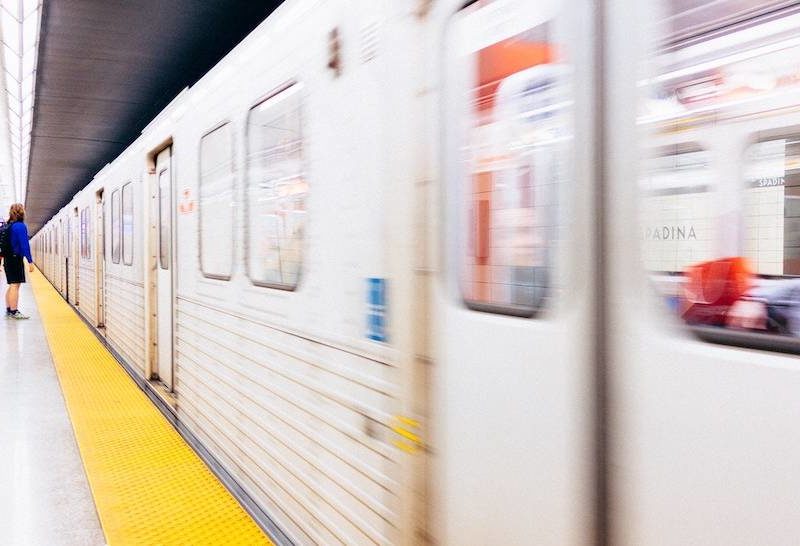
With contributions from Graeme Stewart-Wilson
Part 2
As more people take transit and revenue from fuel tax falls, Metro Vancouver will be increasingly hard-pressed to fund transit expansion.
This is the fundamental challenge that led Metro Vancouver’s Mayors’ Council to seek a new funding source in the upcoming transit and transportation referendum, according to our analysis of TransLink revenue data. Increased transit ridership and a trend towards more fuel-efficient cars are among factors contributing to the future funding shortfall projected by the region’s mayors.
The Mayors’ Council is urging residents of Metro Vancouver to vote “yes” on the ballot. In a letter to B.C. Minister of Transportation Todd Stone, the mayors argued that a 0.5 per cent increase in Provincial Sales Tax (PST) is necessary because regional transportation authority TransLink’s current model lacks “key funding tools necessary to address the region’s needs.”
Critics of the proposed tax claim that cutting the rate of service expansion and increasing TransLink’s efficiency would be enough to make up for budget shortfalls.
According to projections used in the Mayors’ Council’s plan to improve transportation, released in December 2014, TransLink’s revenues are set to grow by nearly $300 million between now and 2023. So why isn’t that growth enough?
We dug into the data on trends impacting the region’s current funding for answers.
Funding won’t keep pace with population growth
In a December letter to the Metro Vancouver Mayors’ Council, Stone wrote that transit expansion is necessary to accommodate the one million new residents expected to arrive in the next 30 years.
This 43 per cent population increase will also contribute additional revenue. But a comparison of TransLink’s projected revenue to population growth estimates shows that funding per capita will increase at a much slower pace than total revenue, inching up by only $40 per capita between 2013 and 2023 (assuming that no new funding source is created). In comparison, funding per capita grew by $230 per capita between 2003 and 2013, when the region added the Canada Line, the Golden Ears Bridge and several other major projects.
This makes it seem like the region could sustain the current level of transportation infrastructure and operations without a new funding source. But that’s not the full story. These revenue numbers are in 2015 dollars, not adjusted for inflation. In reality, $567 per capita set to flow into the system in 2023 won’t pay for the same amount of bus drivers’ salaries and road improvements as it does in 2015. When funding per capita is adjusted for inflation (at a conservative 1.4 per cent annually), as seen in the graph below, it is projected to decline over time.
[iframe url=”https://thediscourse.ca/visualizations/data/Combined.html” mobile-height=”965px” desktop-height=”965px”]
That’s why the Mayors’ Council estimates that the quality of the transportation system will not just flatline, but actually decrease without new funding. For example, they predict that the number of hours of transit service per resident, which peaked in 2009, will decline to 2003 levels by 2023, according the Mayors’ plan for expansion. (We’ll fact check the claims about eroding quality in a future chapter of Moving Forward.)
Why isn’t funding keeping up?
Funding for transportation in the region comes from three major sources: motor fuel tax, property tax and transit fares. These account for more than 75 per cent of TransLink’s annual operating revenue, according to its annual reports. (See the interactive pie chart for a full breakdown of TransLink’s 2013 revenue.)
[iframe url=”https://thediscourse.ca/visualizations/data/Revenues2013.html” mobile-height=”515px” desktop-height=”515px”]
But if the region’s population will expand by one million, these new residents will all be paying transit fares and property taxes, shopping in stores (property taxes are paid by businesses as well as residents) and buying gas for their cars. This begs the question: why won’t those revenue streams increase at a rate needed to accommodate the newcomers?
Property tax
If population and the housing market continue on their upward trajectory, property taxes collected by municipalities in Metro Vancouver will increase too (as shown in the red line in the graph below).
But there’s a catch here: the number of dollars that TransLink collects from the region’s property tax pool—represented in grey on the graph—is not actually connected to property tax growth. Provincial legislation caps the increase in TransLink’s share at three per cent per year, regardless of how much property taxes in the region are rising on the whole. This means that there is actually a widening gap—nearly a full percentage point change over the past five years—between the region’s total property tax take and TransLink’s share of property tax.
[iframe url=”https://thediscourse.ca/visualizations/data/MetroVanandGVTAProp.html” mobile-height=”516px” desktop-height=”516px”]
That also means that the burden added to the transportation system due to the region’s population growth won’t be matched by new property tax revenue generated by new residents and businesses.
Motor fuel tax
Then there’s the motor fuel tax— a flat 17 cents per litre that goes to TransLink every time someone fills their car with gas in Metro Vancouver. That means the more gas is consumed in the region, the more revenue goes toward transportation.
Now consider: the B.C. government and the Metro Vancouver region have set ambitious goals to reduce car travel and increase the number of people who walk, cycle or take transit. TransLink’s current mandate, as stated in the Regional Transportation Strategy, is to reduce the percentage of car trips in Metro Vancouver from 73 to 50 per cent by 2045.
While meeting this target would be good for easing gridlock and reducing pollution, it would result in TransLink bringing in considerably fewer dollars from motor fuel tax. In other words, the better the region does at getting people out of their cars, the less funding there is to build and operate transit.
[iframe url=”https://thediscourse.ca/visualizations/data/MotorFuelRevenues.html” mobile-height=”565px” desktop-height=”565px”]
Since 2001, motor fuel tax has declined from more than 40 per cent to less than 30 per cent of total revenues. Compounding the situation is the fact that cars are getting much more fuel efficient. TransLink estimates that Metro Vancouver residents will consume 60 million fewer litres of fuel per year by 2023, according to its 2014 financial base plan. As a result, motor fuel tax revenues are projected to drop by $21 per capita.
Transit fares
So if more people are using transit, why aren’t their transit fares enough to provide the transit service they need?
Revenue from transit fares increases as more people take transit. However, the cost of servicing each new passenger exceeds the revenue they contribute in fares, as new infrastructure is needed to accommodate growth in ridership. In fact, transit contributes about 38 per cent to overall transportation revenue, but accounts for nearly 66 percent of expenditures (as seen in the pie chart below).
[iframe url=”https://thediscourse.ca/visualizations/data/PieTransitRevenueExpenditures.html” mobile-height=”420px” desktop-height=”420px”]
The majority of development and growth in the region is happening in areas where increasing service is expensive. An analysis of bus service performance in the region shows that the denser and more transit-oriented an area is, the more cost-effective it is to service. For example, the cost of operating the 99 B-Line bus that runs along Broadway in Vancouver is $0.55 cents per passenger that gets on board. The 96 B-Line, a comparable route that runs along King George Boulevard in Surrey, costs $1.61 per boarded passenger − nearly three times as much. This figure can reach above $10 per passenger in extreme cases like the 606 Ladner Ring bus. (We’ll release a tool to help calculate this and other transportation cost considerations in the coming week). This is especially relevant since regions like Surrey (79 per cent population growth by 2041) and Coquitlam (87 per cent) are expected to experience considerably more growth than Vancouver (23 per cent).
This is why a growing take at the farebox isn’t enough to keep up with the cost of servicing new ridership. But supporters of transit expansion say that the impact to the budget can’t be captured solely by looking at transit revenues. (For example, increased congestion due to lack of transit expansion was estimated to cost the region $365 million, according to an HDR study commissioned by TransLink and other stakeholders in the region.)
So, to sum it all up, these trends — population growth, inflation, improving fuel efficiency and more people choosing alternatives to driving — have brought us to this point, where the Mayors’ Council predicts the region won’t have enough funding to maintain current service levels or expand the system in the future.
But why does it cost what it costs to run transit, build roads and keep Metro Vancouver moving? We’ll dig into those numbers next week. [end]
Full disclosure: Reporter Christine McLaren’s partner is an employee of TransLink.



